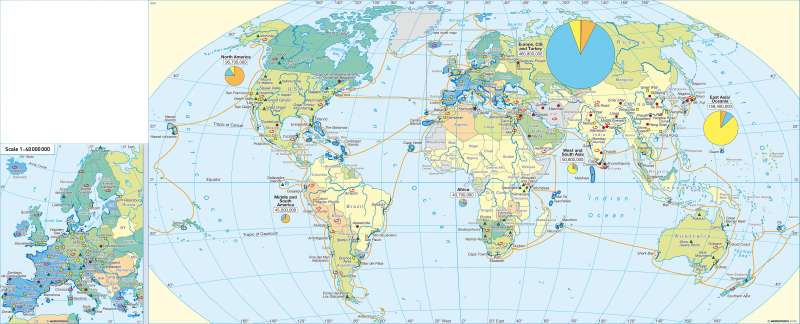Tourism
The world - Tourism
978-3-14-100790-9 | Page 196 | Ill. 1

Information
Mass tourism is a historically recent phenomenon that has evolved as a powerful industry in the few decades of its existence. According to the World Tourism Organization UNWTO, the tourism industry has now an annual turnover of about 2.8 Trillion Euros. Tourists are defined as persons who travel to a place outside their usual environment for recreational, commercial or other purposes and stay there for a minimum period of 24 hours to a maximum of one year.Forms of tourism
Tourism can be divided into different forms. The most basic distinction is between holiday and business travel. Both forms are highly dependent on market and economic trends. Consequently, business travel has increased greatly since the early 1990's through the opening of international commodity markets. However, it is subject to certain fluctuations, such as economic downturns in the global economy or individual sectors, which force many companies to reduce spending on expensive conferences and so on. In the area of private tourism, economic developments are quite noticable as an economic decline is mostly reflected in declining spending on travel.
The forerunner of tourism in the early 19th Century was the summer holidays, which was the extended stay of the privileged middle classes and aristocracy for recovery in the countryside or at the seaside. Toward the end of that century winter tourism in the Alps slowly began. These two classic forms are still available in a modified form, but they have lost importance by a consistent differentiation in the offer to the tourist. The classic family holidays has declined since, as on the one hand, the trend is more towards shorter but more frequent trips to various destinations, on the other hand, urban and cultural tourism has increased thanks to targeted marketing.
In resort regions, the focus is still on family holidays. In recent years employment and entertainment options have been consistently expanded: through sport and spa facilities, affiliated theme parks, the designation of specific cycling and walking routes or by cultural information and sightseeing tours. Today, winter ski resorts advertise various sports and there is the trend of making "snow" with snow cannons. For decades, cruises were a real status symbol, but nowadays they are offered by hundreds of cruise ships at affordable prices. Cruise ships now travel in such large numbers to very remote regions on Earth, such as Antarctica, has caused environmentalists to already be sounding the alarm and reflects the general trend towards adventure tourism. Safari tourism has been given a new mass acceptance and "exotic" destinations in poorer developing countries are increasingly on offer for mass tourism.
Destinations Worldwide
The survey of the travel areas covered show that Europe has not only the most tourists, but that also in terms of tourism, is by far the most developed continent. Among the the world's dense tourist areas are North American Pacific and Atlantic coasts, the Caribbean Islands, some coastal areas and metropolitan areas in East and Southeast Asia, the Maldives and parts of Australia and New Zealand. Of the more than 50 African countries, only Morocco, Tunisia, Egypt and South Africa have any coastal regions. In to this category large parts of the continent and areas of Asia and South America are not accessible for tourism.
Cities are also the focus of tourism, in addition to the European and North American cities, most have either a history or like Dubai and Hong Kong, have developed in a short time, in recent decades to the rank of world cities. Offers for adventure and adventure holidays can be found — for obvious reasons — more in regions which are economically weak and only slightly developed for tourists. Consequently they are able to conserve relics of their former natural wealth. In places such as Africa, the attempt to build sustainable natural tourism has recently been strengthened, which unlike mass tourism, serves to conserve natural resources and provides the local population with a new source of revenue at the same time.
K. Lückemeier; Ü: C. Fleming




